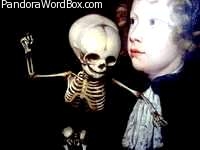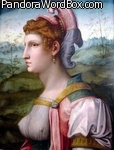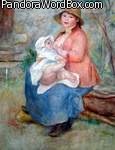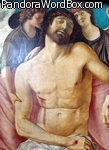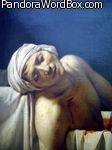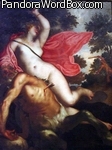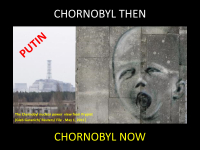Chest is like a TRUNK or a tree after TRUNCATION of its top, roots and branches. The human CHEST or TRUNK is the torso without the head, upper limbs, and the lower half of the body. The idea " CHEST " belongs within a complex of meanings inherent in THORAX PECTORAL BREATH BREAST BOSOM as well as COSTAL COSTADO COSTILLA ACOST pointing to RIB and the RIB CAGE. The roots of CHEST imply "a cavity" and stem from KIST, CIST CYST or KIST. These words emerged from kusthas, kustis and cystis in Sanskrit, Greek and Latin denoting " a sac ", bladder or basket. In mammals, the chest is a rigid cavity, or a cage formed by ribs and containing the lungs. A STERN stiff STERNUM constitutes the anterior chest wall. On each side of the midline is the mammary region where feminine BREASTS develop (or SENOS in Spanish). Between mature breasts or SENOS is a cleavage or BOSOM (like an enSENAda in Spanish). Note that in military parlance "BREAST WORKS" imply forward structures and in popular parlance "to keep abreast" implies to be aware of advances. The stress on "forward" is also evident in the medical term ESCUTCHEON implying that the chest is like a "shield" or ESCUDO in Spanish. In short, chest conveys a dual concurrent sense of the hardness and rigidity of costal and sternal structures and the softness of the female bosom.
Hard and soft are implicit in Chest vs. Bosom
In contrast to cysts or collapsible bags, the CHEST is hard and rigid as expressed in Ukrainian by HRYDY, HRAN, HRAD, HRUDA, HRUDEN for chest, grain, hailstone or the hardened lumps of frozen mud typical of cold Decembers. Shifting from HRA to GRA the connection with GRAin, GRAm, GRAphic, among other expressions of implicit "hardness", is obvious. On the other hand, the softness of mature BREASTS or BOSOM and the cleavage between them is illustrated in Spanish by SENo and eSENada implying a refuge or cove. An infant being breastfed finds a soft warm harbor between the maternal SENOS as it is breast fed. Adults also find having a "bosom buddy" to be confronting.
Chest, breast, cleavage, bust, bosom, nurturing, nursing ... bosom buddies.
The ancients likened the rib cage or thorax with a "comb" or basket composed of ribs stiffened by a STERN STERNum anchoring their anterior ends. At first, the STERnum is cartilaginous but with aging acquires STRAta and becomes HAR as a HRUDA as given by Ukrainian terms mentioned earlier. The same is inherent in CLOT denoted a hardening and in this sense CHEESE and CHEST reflect hardened matter.
Chest wounds that allow air to enter into the thorax eliminate the capacity of an expanding chest cavity to pull the lungs along to produce an inspiration or aspiration of air. Expiration of air is mostly due to the passive contraction of the elastic rib cage and lungs previously expanded by the respiratory muscles (mainly the diaphragm). The vacuum between the chest and lungs secured by an intact pleural membrane covering the chest wall and the lungs insures that when the chest walls expand, the lungs follow and become filled with fresh air. Once the seal of the pleura is perforated and air penetrates the space between the lungs and chest wall, the lungs being elastic, collapse (pneumothorax). Only recently did Medicine developed techniques to open the chest safely and repair perforating chest wounds which often are otherwise fatal.
In IndoEuropean, PEKTOS means COMB, edge or ridge, which is a characteristic of the breast plate or sternum of many birds. In Latin and Spanish, PECTO, PECHO and PEINE denote thorax, rake and comb. In Ukrainian HREB, HREBIN, HREBLA, and HRUD also denote fork, comb, ridge, and chest. In the sense of edge or ridge, the cock and other male birds, often have heads decorated by a COMB or a colorful ridge, a feature envied and formerly copied by cocky warriors.
This escutcheon demonstrates a Pectus excavatum or concave sternum
The shape of the chest or ESCUCHEON is like a shield or SCUTus or eSCUDo in Latin and Spanish. Unduly prominent or sunken breastbones or sterna reflect deformations of the eSTUCheon. In medical parlance, PECTUS CARINATUM describes keel or CARINA like chests and PECTUS EXCAVATUM those who are sunken.
THORAX is grounded in KHORonyty, KHARayati and DAR, ancient roots for "burial", "hold" and coffin. A poetic but more speculative vista links THORAX with THOLUS which refers to concave "vaults" or tombs. This view is concordant with HRUD, HRUNT, HROBAR and HRIB which in Ukrainian convey ideas of prominence, chest, ground, undertaker and tomb.
Regarding CHEST as in "chestnut", the term combines ideas about "hard" with "hazel" nut and also names a tine distinct from brown, beige or mahogany like colors.
With RESPect to RESPiration the axis BREATH BREAST, perhaps a RESPite is in order. After a REST, the rest of vistas concerning INSPIRE and EXPIRE can be explored in an overview concerned with RESPIRATION.
Perforation of the chest causes pneumothorax wich was mostly lethal until medical advances achieved during the last 50 or so years.
W. Wertelecki, M.D. 20091129a




